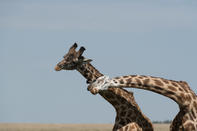
Temporary Associations
Giraffe have very loose social structures known as temporary associations. Within a period of hours, the individuals making up a group will fluctuate and no lasting bonds exist between members (except initially between mothers and calves).
Giraffe are gregarious and still prefer to be around members of their own kind even though the makeup of the group fluctuates. Bachelors generally associate with bachelors and maternity groups or crèches tend to form but any combination of sex and age may be found.
The vantage point created by the giraffe’s height allows separated individuals to maintain visual contact. The skin behind their ears is white and obvious from behind, a lofty ‘follow me’ sign and contact beacon well suited to giraffe. Bull giraffe are generally solitary and move from one temporary association to the next seeking cows on heat. Giraffe are not territorial and a local status hierarchy develops according to age and size.
This is established through ritual necking encounters amongst bachelors from an early age. Duels are not violent unless two equally matched bulls are contending for the same oestrus cow.
Necking rituals are synchronized and seem like a graceful dance but the ultimate intention is for one bull to thrust his neck sideways making well-placed blows with his horns and knobbly head on the opponent’s body while the two stand side on, head-to-rump. The opponent does his best to avoid blows and reciprocate the attacks and a rhythmical movement ensues.
By Megan Emmett